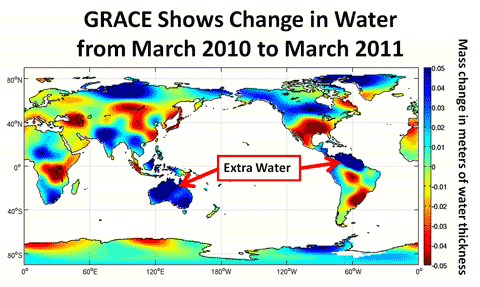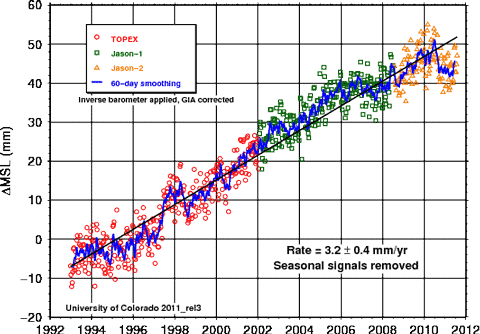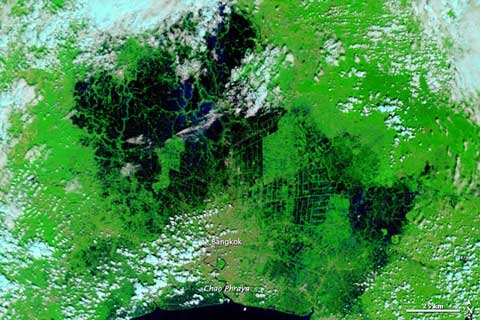Thailand is experiencing its worst monsoon flooding for at least 50 years. The NASA Earth Observatory image above shows the waters piling up to the North of the capital Bangkok, which is already beginning to experience flooding (visit the EO page to see a comparison with earlier floods, and The Guardian for a striking set of flood pictures). The Thai government yesterday declared a five day weekend to allow the city’s inhabitants to make preparations. The intense monsoon season has also brought extensive flooding to Cambodia and northeastern India over the last couple of months, and destroyed a significant part of SE Asia’s rice crop. On the other side of the planet, heavy rain and flooding has been affecting Mexico, El Salvador, Costa Rica, Honduras, Guatemala, and Nicaragua. Jeff Masters reported that in the ten days up to October 20th, Huizucar in El Salvador received an astonishing 1.513 metres of rain.
At first glance, it looks like a continuation of the remarkable series of extreme weather events — especially heavy rainfall and flooding — that we’ve seen over the last few years. But apart from the human suffering and economic dislocation being experienced around the world, it appears there’s another interesting consequence of all this precipitation — it’s causing global sea level to fall.
I stumbled across this idea in a NASA news item released back in August, and referred to it in the last edition of The Climate Show, but I think it’s worth developing the idea a little further. Here’s what NASA had to say:
[Josh] Willis said that while 2010 began with a sizable El Niño, by year’s end, it was replaced by one of the strongest La Niñas in recent memory. This sudden shift in the Pacific changed rainfall patterns all across the globe, bringing massive floods to places like Australia and the Amazon basin, and drought to the southern United States.
Data from the NASA/German Aerospace Center’s twin Gravity Recovery and Climate Experiment (Grace) spacecraft provide a clear picture of how this extra rain piled onto the continents in the early parts of 2011. “By detecting where water is on the continents, Grace shows us how water moves around the planet,” says Steve Nerem, a sea level scientist at the University of Colorado in Boulder.
So where does all that extra water in Brazil and Australia come from? You guessed it–the ocean. Each year, huge amounts of water are evaporated from the ocean. While most of it falls right back into the ocean as rain, some of it falls over land. “This year, the continents got an extra dose of rain, so much so that global sea levels actually fell over most of the last year,” says Carmen Boening, a JPL oceanographer and climate scientist. Boening and colleagues presented these results recently at the annual Grace Science Team Meeting in Austin, Texas.
The story included a couple of graphs to illustrate the point. Here’s the drop in sea level, as recorded by satellite:

And here’s where the GRACE satellites showed it ended up.

When I first read the NASA article, I was amazed. Perhaps I shouldn’t have been. After all, lots of things can cause sea level to rise and fall — thermal expansion, ice melt (or freeze), and so on. During ice ages lots of ocean ends up on land in the form of the great ice sheets that are built by accumulating snowfall. But this is, to coin a phrase, a really neat demonstration of an interesting effect — one that we can only begin to appreciate because of the application of truly remarkable technology.
So what’s happening now? Here’s the latest sea level chart from the University of Colorado (data to Sept 19th):

There’s been a slight upwards tick over the last few months, but no dramatic surge back towards to the trend line. That suggests to me that the processes that caused the drop in the first place are still operating. The population of Thailand might agree…
Eventually, as Josh Willis says at the conclusion of the NASA article, the floodwaters will run off the land and return to the ocean, La Niña will swing back to El Niño, and sea level rise will resume its upwards trajectory. With La Niña likely to stay in place through the southern summer, it will be some time before El Niño returns and imposes its own pattern on the world’s weather. But when it does we could be in for a wild ride as sea level surges and global temperatures reach new peaks. We live in interesting times.
[Update 27/10] Flash flooding has ripped through Liguria and Tuscany in Italy. Both the Guardian and BBC videos open with water roaring down the streets of (I think) Monterosso — a place I visited in September. Dublin has also experienced torrential rain and flash flooding in the last few days: video here. Intensification of the hydrological cycle anyone?


Amazing and terrifying at the same time to observe these effects as they happen and see the distribution of water due to a warmer atmosphere live… 3.2mm of ocean level evaporated and dumped as deluge on flood ridden lands, not just in Thailand but now also in Italy:
http://www.abc.net.au/news/2011-10-27/floods-hit-italy/3602764?section=world
As a side: The latest New Scientist has a good summary of all things AGW if you need some reading material for your denier mates….
And it adds the confirmation that we have most likely booked a seal level rise of many meters, perhaps 20, for a sustained one degree average temperature rise. At least that is the very valid comparison with past warm periods that have seen this sort of sea level rise when average temperatures were 1 deg above our ‘normal’ for a sustained time…
Just spotted a blooper in my post: But indeed, “Seal” levels will rise too (basking higher up the beach) with the rising tides… 😉
And the NS article actually said that a sustained 1 to 2 deg temp rise would likely result in an eventual 25m of sea (and seal) level rise…
Thanks for the tip on the NS, Thomas; I’m thoroughly enjoying the elegant summation of the situation as it stands – what we know, and what we don’t.
Ooh, potential doubt!… Don’t hold out hopes of any straws to clutch, Contrarians – as the accompanying editorial explains, the major ‘what we do know’ is that we have a real problem, and every minute we delay doing something about it it gets worse.
(I’m also enjoying reading an NS that doesn’t feature any of the writings of the man who finally caused me to give up on my subscription years ago – Fred Pearce!)
Yes, I was almost relived to read that NS after reading some rather questionable and ill researched articles over the years on matters that there not even close to getting past any peer review yet made it into the copy selling tile page rants normally reserved for the tabloids.
And Ireland too, severe flooding in Dublin: http://www.euronews.net/nocomment/2011/10/25/ireland-dublin-under-water/
The Thai shrimp farming industry was hard hit by April flooding , I wonder how sensitive the industry will be to this event
Escaped crocodiles are a problem too…
Meanwhile Weetbix are flying of the shelf in Auckland as the supply may be interrupted due to the gas pipeline rupture…. 😉
Humor aside, the NZ gas pipe issues are a very timely reminder how severely all of our economy’s activities are hanging of the Achilles Heel of fossil fuels flowing unabated and how enormous and intricate the task actually would be if anybody was indeed trying to reduce our CO2 emissions in a sustained manner without just resulting to paper shuffling and creative emissions accounting but actually use much less!
It seems that raising fuel cost through taxation of Carbon fuel production at the source (Production and Import) is perhaps the only way to create incentives for our industries and individuals to prepare for our post-carbon fuel world and to engage proactively with the path to the only future we can realistically afford to live…
An interesting effect of this might be the distribution of the sea level…. Where the land water drains back to the oceans the local sea level will be relatively higher I would think for a couple of reasons than elsewhere.
Worth seeing the follow-up video from Italy on the Guardian site.
I hereby post this Post-Muller excerpt – without further comment, as it’s hardly required – from Watts’ blog –
Joe Romm on El Salvador.
I’ll note there have been no comments from Watts’ fellow-travellers on that remarkably asinine quote I posted directly above! 😉